Comparison of Scanning LiDAR with Other Remote Sensing Measurements and Transport Model Predictions for a Saharan Dust Case
Abstract
1. Introduction
2. Methods
2.1. Remote Sensing Instruments
2.2. Aerosol Transport Modelling
3. Results and Discussion
3.1. Application of Two-Angle LiDAR Measurements for a Saharan Dust Case
3.2. Characteristic Properties of the Saharan Dust Determined by Remote Sensing
3.3. Model–Observation Comparison
4. Conclusions
Supplementary Materials
Author Contributions
Funding
Institutional Review Board Statement
Informed Consent Statement
Data Availability Statement
Conflicts of Interest
Abbreviations
| KASCAL | Karlsruhe Scanning Aerosol LiDAR |
| DWD-DELiRA | Deutscher Wetterdienst-Depolarization Raman LiDAR |
References
- Stocker, T. Climate Change 2013: The Physical Science Basis: Working Group I Contribution to the Fifth Assessment Report of the Intergovernmental Panel on Climate Change; Cambridge University Press: Cambridge, UK, 2014. [Google Scholar]
- Satheesh, S.; Srinivasan, J.; Moorthy, K. Spatial and temporal heterogeneity in aerosol properties and radiative forcing over Bay of Bengal: Sources and role of aerosol transport. J. Geophys. Res. Atmos. 2006, 111. [Google Scholar] [CrossRef]
- Ansmann, A.; Tesche, M.; Althausen, D.; Müller, D.; Seifert, P.; Freudenthaler, V.; Heese, B.; Wiegner, M.; Pisani, G.; Knippertz, P.; et al. Influence of Saharan dust on cloud glaciation in southern Morocco during the Saharan Mineral Dust Experiment. J. Geophys. Res. Atmos. 2008, 113. [Google Scholar] [CrossRef]
- Su, J.; Huang, J.; Fu, Q.; Minnis, P.; Ge, J.; Bi, J. Estimation of Asian dust aerosol effect on cloud radiation forcing using Fu-Liou radiative model and CERES measurements. Atmos. Chem. Phys. 2008, 8, 2763–2771. [Google Scholar]
- DeMott, P.J.; Prenni, A.J.; McMeeking, G.R.; Sullivan, R.C.; Petters, M.D.; Tobo, Y.; Niemand, M.; Möhler, O.; Snider, J.R.; Wang, Z.; et al. Integrating laboratory and field data to quantify the immersion freezing ice nucleation activity of mineral dust particles. Atmos. Chem. Phys. 2015, 15, 393–409. [Google Scholar] [CrossRef]
- Möhler, O.; Adams, M.; Lacher, L.; Vogel, F.; Nadolny, J.; Ullrich, R.; Boffo, C.; Pfeuffer, T.; Hobl, A.; Weiß, M.; et al. The Portable Ice Nucleation Experiment (PINE): A new online instrument for laboratory studies and automated long-term field observations of ice-nucleating particles. Atmos. Meas. Tech. 2021, 14, 1143–1166. [Google Scholar] [CrossRef]
- Brunner, C.; Brem, B.T.; Collaud Coen, M.; Conen, F.; Hervo, M.; Henne, S.; Steinbacher, M.; Gysel-Beer, M.; Kanji, Z.A. The contribution of Saharan dust to the ice-nucleating particle concentrations at the High Altitude Station Jungfraujoch (3580 m a.s.l.), Switzerland. Atmos. Chem. Phys. 2021, 21, 18029–18053. [Google Scholar] [CrossRef]
- Niemand, M.; Möhler, O.; Vogel, B.; Vogel, H.; Hoose, C.; Connolly, P.; Klein, H.; Bingemer, H.; DeMott, P.; Skrotzki, J.; et al. A particle-surface-area-based parameterization of immersion freezing on desert dust particles. J. Atmos. Sci. 2012, 69, 3077–3092. [Google Scholar] [CrossRef]
- Min, Q.L.; Li, R.; Lin, B.; Joseph, E.; Wang, S.; Hu, Y.; Morris, V.; Chang, F. Evidence of mineral dust altering cloud microphysics and precipitation. Atmos. Chem. Phys. 2009, 9, 3223–3231. [Google Scholar] [CrossRef]
- Karydis, V.A.; Tsimpidi, A.P.; Bacer, S.; Pozzer, A.; Nenes, A.; Lelieveld, J. Global impact of mineral dust on cloud droplet number concentration. Atmos. Chem. Phys. 2017, 17, 5601–5621. [Google Scholar] [CrossRef]
- Meloni, D.; Di Sarra, A.; Di Iorio, T.; Fiocco, G. Influence of the vertical profile of Saharan dust on the visible direct radiative forcing. J. Quant. Spectrosc. Radiat. Transf. 2005, 93, 397–413. [Google Scholar] [CrossRef]
- Ma, P.L.; Rasch, P.J.; Chepfer, H.; Winker, D.M.; Ghan, S.J. Observational constraint on cloud susceptibility weakened by aerosol retrieval limitations. Nat. Commun 2018, 9, 1–10. [Google Scholar] [CrossRef]
- Freudenthaler, V.; Esselborn, M.; Wiegner, M.; Heese, B.; Tesche, M.; Ansmann, A.; Müller, D.; Althausen, D.; Wirth, M.; Fix, A.; et al. Depolarization ratio profiling at several wavelengths in pure Saharan dust during SAMUM 2006. Tellus B Chem. Phys. Meteorol. 2009, 61, 165–179. [Google Scholar] [CrossRef]
- Kanitz, T.; Engelmann, R.; Heinold, B.; Baars, H.; Skupin, A.; Ansmann, A. Tracking the Saharan Air Layer with shipborne LiDAR across the tropical Atlantic. Geophys. Res. Lett. 2014, 41, 1044–1050. [Google Scholar] [CrossRef]
- Soupiona, O.; Papayannis, A.; Kokkalis, P.; Foskinis, R.; Sánchez Hernández, G.; Ortiz-Amezcua, P.; Mylonaki, M.; Papanikolaou, C.A.; Papagiannopoulos, N.; Samaras, S.; et al. EARLINET observations of Saharan dust intrusions over the northern Mediterranean region (2014–2017): Properties and impact on radiative forcing. Atmos. Chem. Phys. 2020, 20, 15147–15166. [Google Scholar] [CrossRef]
- Marinou, E.; Amiridis, V.; Binietoglou, I.; Tsikerdekis, A.; Solomos, S.; Proestakis, E.; Konsta, D.; Papagiannopoulos, N.; Tsekeri, A.; Vlastou, G.; et al. Three-dimensional evolution of Saharan dust transport towards Europe based on a 9-year EARLINET-optimized CALIPSO dataset. Atmos. Chem. Phys. 2017, 17, 5893–5919. [Google Scholar] [CrossRef]
- Akritidis, D.; Katragkou, E.; Georgoulias, A.K.; Zanis, P.; Kartsios, S.; Flemming, J.; Inness, A.; Douros, J.; Eskes, H. A complex aerosol transport event over Europe during the 2017 Storm Ophelia in CAMS forecast systems: Analysis and evaluation. Atmos. Chem. Phys. 2020, 20, 13557–13578. [Google Scholar] [CrossRef]
- Osborne, M.; Malavelle, F.F.; Adam, M.; Buxmann, J.; Sugier, J.; Marenco, F.; Haywood, J. Saharan dust and biomass burning aerosols during ex-hurricane Ophelia: Observations from the new UK LiDAR and sun-photometer network. Atmos. Chem. Phys. 2019, 19, 3557–3578. [Google Scholar] [CrossRef]
- Mona, L.; Papagiannopoulos, N.; Basart, S.; Baldasano, J.; Binietoglou, I.; Cornacchia, C.; Pappalardo, G. EARLINET dust observations vs. BSC-DREAM8b modelled profiles: 12-year-long systematic comparison at Potenza, Italy. Atmos. Chem. Phys. 2014, 14, 8781–8793. [Google Scholar] [CrossRef]
- Müller, D.; Weinzierl, B.; Petzold, A.; Kandler, K.; Ansmann, A.; Müller, T.; Tesche, M.; Freudenthaler, V.; Esselborn, M.; Heese, B.; et al. Mineral dust observed with AERONET Sun photometer, Raman LiDAR, and in situ instruments during SAMUM 2006: Shape-independent particle properties. J. Geophys. Res. Atmos. 2010, 115. [Google Scholar] [CrossRef]
- Groß, S.; Tesche, M.; Freudenthaler, V.; Toledano, C.; Wiegner, M.; Ansmann, A.; Althausen, D.; Seefeldner, M. Characterization of Saharan dust, marine aerosols and mixtures of biomass-burning aerosols and dust by means of multi-wavelength depolarization and Raman LiDAR measurements during SAMUM 2. Tellus B Chem. Phys. Meteorol. 2011, 63, 706–724. [Google Scholar] [CrossRef]
- Heintzenberg, J. The SAMUM-1 experiment over Southern Morocco: Overview and introduction. Tellus B Chem. Phys. Meteorol. 2009, 61, 2–11. [Google Scholar] [CrossRef]
- Petzold, A.; Rasp, K.; Weinzierl, B.; Esselborn, M.; Hamburger, T.; Doernbrack, A.; Kandler, K.; SchuüTZ, L.; Knippertz, P.; Fiebig, M.; et al. Saharan dust absorption and refractive index from aircraft-based observations during SAMUM 2006. Tellus B Chem. Phys. Meteorol. 2009, 61, 118–130. [Google Scholar] [CrossRef]
- Kandler, K.; Schütz, L.; Deutscher, C.; Ebert, M.; Hofmann, H.; Jäckel, S.; Jaenicke, R.; Knippertz, P.; Lieke, K.; Massling, A.; et al. Size distribution, mass concentration, chemical and mineralogical composition and derived optical parameters of the boundary layer aerosol at Tinfou, Morocco, during SAMUM 2006. Tellus B Chem. Phys. Meteorol. 2009, 61, 32–50. [Google Scholar] [CrossRef]
- Weinzierl, B.; Petzold, A.; Esselborn, M.; Wirth, M.; Rasp, K.; Kandler, K.; Schuetz, L.; Koepke, P.; Fiebig, M. Airborne measurements of dust layer properties, particle size distribution and mixing state of Saharan dust during SAMUM 2006. Tellus B Chem. Phys. Meteorol. 2009, 61, 96–117. [Google Scholar] [CrossRef]
- Kandler, K.; Lieke, K.; Benker, N.; Emmel, C.; Küpper, M.; Müller-Ebert, D.; Ebert, M.; Scheuvens, D.; Schladitz, A.; Schütz, L.; et al. Electron microscopy of particles collected at Praia, Cape Verde, during the Saharan Mineral Dust Experiment: Particle chemistry, shape, mixing state and complex refractive index. Tellus B Chem. Phys. Meteorol. 2011, 63, 475–496. [Google Scholar] [CrossRef]
- Ansmann, A.; Petzold, A.; Kandler, K.; Tegen, I.; Wendisch, M.; Mueller, D.; Weinzierl, B.; Mueller, T.; Heintzenberg, J. Saharan Mineral Dust Experiments SAMUM–1 and SAMUM–2: What have we learned? Tellus B Chem. Phys. Meteorol. 2011, 63, 403–429. [Google Scholar] [CrossRef]
- Schladitz, A.; Müller, T.; Nordmann, S.; Tesche, M.; Gross, S.; Freudenthaler, V.; Gasteiger, J.; Wiedensohler, A. In situ aerosol characterization at Cape Verde: Part 2: Parametrization of relative humidity-and wavelength-dependent aerosol optical properties. Tellus B Chem. Phys. Meteorol. 2011, 63, 549–572. [Google Scholar] [CrossRef][Green Version]
- Weinzierl, B.; Sauer, D.; Esselborn, M.; Petzold, A.; Veira, A.; Rose, M.; Mund, S.; Wirth, M.; Ansmann, A.; Tesche, M.; et al. Microphysical and optical properties of dust and tropical biomass burning aerosol layers in the Cape Verde region—An overview of the airborne in situ and LiDAR measurements during SAMUM-2. Tellus B Chem. Phys. Meteorol. 2011, 63, 589–618. [Google Scholar] [CrossRef]
- Haarig, M.; Walser, A.; Ansmann, A.; Dollner, M.; Althausen, D.; Sauer, D.; Farrell, D.; Weinzierl, B. Profiles of cloud condensation nuclei, dust mass concentration, and ice-nucleating-particle-relevant aerosol properties in the Saharan Air Layer over Barbados from polarization LiDAR and airborne in situ measurements. Atmos. Chem. Phys. 2019, 19, 13773–13788. [Google Scholar] [CrossRef]
- Papayannis, A.; Mamouri, R.E.; Amiridis, V.; Remoundaki, E.; Tsaknakis, G.; Kokkalis, P.; Veselovskii, I.; Kolgotin, A.; Nenes, A.; Fountoukis, C. Optical-microphysical properties of Saharan dust aerosols and composition relationship using a multi-wavelength Raman LiDAR, in situ sensors and modelling: A case study analysis. Atmos. Chem. Phys. 2012, 12, 4011–4032. [Google Scholar] [CrossRef]
- Perrone, M.R.; Barnaba, F.; De Tomasi, F.; Gobbi, G.P.; Tafuro, A.M. Imaginary refractive-index effects on desert-aerosol extinction versus backscatter relationships at 351 nm: Numerical computations and comparison with Raman LiDAR measurements. Appl. Opt. 2004, 43, 5531–5541. [Google Scholar] [CrossRef] [PubMed]
- Killinger, D.K.; Menyuk, N. Laser remote sensing of the atmosphere. Science 1987, 235, 37–45. [Google Scholar] [CrossRef] [PubMed]
- Fernald, F.G. Analysis of atmospheric LiDAR observations: Some comments. Appl. Opt. 1984, 23, 652–653. [Google Scholar] [CrossRef] [PubMed]
- Klett, J.D. LiDAR inversion with variable backscatter/extinction ratios. Appl. Opt. 1985, 24, 1638–1643. [Google Scholar] [CrossRef] [PubMed]
- Haarig, M.; Ansmann, A.; Baars, H.; Jimenez, C.; Veselovskii, I.; Engelmann, R.; Althausen, D. Depolarization and LiDAR ratios at 355, 532, and 1064 nm and microphysical properties of aged tropospheric and stratospheric Canadian wildfire smoke. Atmos. Chem. Phys. 2018, 18, 11847–11861. [Google Scholar] [CrossRef]
- Haarig, M.; Ansmann, A.; Engelmann, R.; Baars, H.; Toledano, C.; Torres, B.; Althausen, D.; Radenz, M.; Wandinger, U. First triple-wavelength LiDAR observations of depolarization and extinction-to-backscatter ratios of Saharan dust. Atmos. Chem. Phys. 2022, 22, 355–369. [Google Scholar] [CrossRef]
- Lei, L.; Berkoff, T.A.; Gronoff, G.P.; Su, J.; Nehrir, A.R.; Wu, Y.; Moshary, F.; Kuang, S. Retrieval of UVB aerosol extinction profiles from the ground-based Langley Mobile Ozone LiDAR (LMOL) system. Atmos. Meas. Tech. Discuss. 2021, 2021, 1–22. [Google Scholar] [CrossRef]
- Wandinger, U. Raman LiDAR. In LiDAR; Springer: Berlin/Heidelberg, Germany, 2005; pp. 241–271. [Google Scholar]
- Liu, Z.; Matsui, I.; Sugimoto, N. High-spectral-resolution LiDAR using an iodine absorption filter for atmospheric measurements. Opt. Eng. 1999, 38, 1661–1670. [Google Scholar] [CrossRef]
- Piironen, P.; Eloranta, E. Demonstration of a high-spectral-resolution LiDAR based on an iodine absorption filter. Opt. Lett. 1994, 19, 234–236. [Google Scholar]
- Schillinger, M.; Morancais, D.; Fabre, F.; Culoma, A.J. ALADIN: The LiDAR instrument for the AEOLUS mission. In Sensors, Systems, and Next-Generation Satellites VI; Fujisada, H., Lurie, J.B., Aten, M.L., Weber, K., Lurie, J.B., Aten, M.L., Weber, K., Eds.; International Society for Optics and Photonics, SPIE: Bellingham, WA, USA, 2003; Volume 4881, pp. 40–51. [Google Scholar]
- Chen, W.N.; Chen, Y.W.; Chou, C.C.; Chang, S.Y.; Lin, P.H.; Chen, J.P. Columnar optical properties of tropospheric aerosol by combined LiDAR and sun photometer measurements at Taipei, Taiwan. Atmos. Environ. 2009, 43, 2700–2708. [Google Scholar] [CrossRef]
- Wang, J.; Liu, W.; Liu, C.; Zhang, T.; Liu, J.; Chen, Z.; Xiang, Y.; Meng, X. The determination of aerosol distribution by a no-blind-zone scanning LiDAR. Remote Sens. 2020, 12, 626. [Google Scholar] [CrossRef]
- Behrendt, A.; Pal, S.; Wulfmeyer, V.; Lammel, G. A novel approach for the characterization of transport and optical properties of aerosol particles near sources–Part I: Measurement of particle backscatter coefficient maps with a scanning UV LiDAR. Atmos. Environ. 2011, 45, 2795–2802. [Google Scholar] [CrossRef]
- Fortich, A.D.; Dominguez, V.; Wu, Y.; Gross, B.; Moshary, F. Observations of Aerosol Spatial Distribution and Emissions in New York City Using a Scanning Micro Pulse LiDAR. In EPJ Web of Conferences; EDP Sciences: Hefei, China, 2020; Volume 237, p. 03020. [Google Scholar]
- Ma, X.; Wang, C.; Han, G.; Ma, Y.; Li, S.; Gong, W.; Chen, J. Regional atmospheric aerosol pollution detection based on LiDAR remote sensing. Remote Sens. 2019, 11, 2339. [Google Scholar]
- Kokhanenko, G.P.; Balin, Y.S.; Klemasheva, M.G.; Nasonov, S.V.; Novoselov, M.M.; Penner, I.E.; Samoilova, S.V. Scanning polarization LiDAR LOSA-M3: Opportunity for research of crystalline particle orientation in the ice clouds. Atmos. Meas. Tech. 2020, 13, 1113–1127. [Google Scholar] [CrossRef]
- Adam, M. Vertical versus scanning LiDAR measurements in a horizontally homogeneous atmosphere. Appl. Opt. 2012, 51, 4491–4500. [Google Scholar] [CrossRef]
- Gutkowicz-Krusin, D. Multiangle LiDAR performance in the presence of horizontal inhomogeneities in atmospheric extinction and scattering. Appl. Opt. 1993, 32, 3266–3272. [Google Scholar] [CrossRef]
- Kovalev, V.; Wold, C.; Petkov, A.; Hao, W.M. Modified technique for processing multiangle LiDAR data measured in clear and moderately polluted atmospheres. Appl. Opt. 2011, 50, 4957–4966. [Google Scholar] [CrossRef]
- Kovalev, V.; Wold, C.; Petkov, A.; Hao, W.M. Direct multiangle solution for poorly stratified atmospheres. Appl. Opt. 2012, 51, 6139–6146. [Google Scholar] [CrossRef]
- Kovalev, V.; Wold, C.; Petkov, A.; Hao, W.M. Backscatter near-end solution in processing of scanning LiDAR data. Appl. Opt. 2015, 54, 7335–7341. [Google Scholar] [CrossRef] [PubMed]
- Holben, B.N.; Eck, T.F.; Slutsker, I.; Tanre, D.; Buis, J.; Setzer, A.; Vermote, E.; Reagan, J.A.; Kaufman, Y.; Nakajima, T.; et al. AERONET—A federated instrument network and data archive for aerosol characterization. Remote Sens. Environ. 1998, 66, 1–16. [Google Scholar] [CrossRef]
- Holben, B.N.; Tanre, D.; Smirnov, A.; Eck, T.; Slutsker, I.; Abuhassan, N.; Newcomb, W.; Schafer, J.; Chatenet, B.; Lavenu, F.; et al. An emerging ground-based aerosol climatology: Aerosol optical depth from AERONET. J. Geophys. Res. Atmos. 2001, 106, 12067–12097. [Google Scholar] [CrossRef]
- Pozzoli, L.; Bey, I.; Rast, S.; Schultz, M.; Stier, P.; Feichter, J. Trace gas and aerosol interactions in the fully coupled model of aerosol-chemistry-climate ECHAM5-HAMMOZ: 1. Model description and insights from the spring 2001 TRACE-P experiment. J. Geophys. Res. Atmos. 2008, 113. [Google Scholar] [CrossRef]
- Pozzoli, L.; Bey, I.; Rast, S.; Schultz, M.; Stier, P.; Feichter, J. Trace gas and aerosol interactions in the fully coupled model of aerosol-chemistry-climate ECHAM5-HAMMOZ: 2. Impact of heterogeneous chemistry on the global aerosol distributions. J. Geophys. Res. Atmos. 2008, 113. [Google Scholar] [CrossRef]
- Roeckner, E.; Brokopf, R.; Esch, M.; Giorgetta, M.; Hagemann, S.; Kornblueh, L.; Manzini, E.; Schlese, U.; Schulzweida, U. Sensitivity of simulated climate to horizontal and vertical resolution in the ECHAM5 atmosphere model. J. Clim. 2006, 19, 3771–3791. [Google Scholar] [CrossRef]
- Jöckel, P.; Tost, H.; Pozzer, A.; Brühl, C.; Buchholz, J.; Ganzeveld, L.; Hoor, P.; Kerkweg, A.; Lawrence, M.; Sander, R.; et al. The atmospheric chemistry general circulation model ECHAM5/MESSy1: Consistent simulation of ozone from the surface to the mesosphere. Atmos. Chem. Phys. 2006, 6, 5067–5104. [Google Scholar] [CrossRef]
- Jöckel, P.; Kerkweg, A.; Pozzer, A.; Sander, R.; Tost, H.; Riede, H.; Baumgaertner, A.; Gromov, S.; Kern, B. Development cycle 2 of the modular earth submodel system (MESSy2). Geosci. Model Dev. 2010, 3, 717–752. [Google Scholar] [CrossRef]
- Kunz, A.; Pan, L.; Konopka, P.; Kinnison, D.; Tilmes, S. Chemical and dynamical discontinuity at the extratropical tropopause based on START08 and WACCM analyses. J. Geophys. Res. Atmos. 2011, 116. [Google Scholar] [CrossRef]
- Smith, A.K.; Garcia, R.R.; Marsh, D.R.; Richter, J.H. WACCM simulations of the mean circulation and trace species transport in the winter mesosphere. J. Geophys. Res. Atmos. 2011, 116. [Google Scholar] [CrossRef]
- Chapman, E.; Gustafson, W.; Easter, R.; Barnard, J.; Ghan, S.; Pekour, M.; Fast, J. Coupling aerosol-cloud-radiative processes in the WRF-Chem model: Investigating the radiative impact of elevated point sources. Atmos. Chem. Phys. Discuss 2008, 8, 14–765. [Google Scholar] [CrossRef]
- Vogel, H.; Förstner, J.; Vogel, B.; Hanisch, T.; Mühr, B.; Schättler, U.; Schad, T. Time-lagged ensemble simulations of the dispersion of the Eyjafjallajökull plume over Europe with COSMO-ART. Atmos. Chem. Phys. 2014, 14, 7837–7845. [Google Scholar] [CrossRef]
- Rieger, D.; Steiner, A.; Bachmann, V.; Gasch, P.; Förstner, J.; Deetz, K.; Vogel, B.; Vogel, H. Impact of the 4 April 2014 Saharan dust outbreak on the photovoltaic power generation in Germany. Atmos. Chem. Phys. 2017, 17, 13391–13415. [Google Scholar] [CrossRef]
- Weimer, M.; Schröter, J.; Eckstein, J.; Deetz, K.; Neumaier, M.; Fischbeck, G.; Hu, L.; Millet, D.B.; Rieger, D.; Vogel, H.; et al. An emission module for ICON-ART 2.0: Implementation and simulations of acetone. Geosci. Model Dev. 2017, 10, 2471–2494. [Google Scholar] [CrossRef]
- Tegen, I.; Fung, I. Modeling of mineral dust in the atmosphere: Sources, transport, and optical thickness. J. Geophys. Res. Atmos. 1994, 99, 22897–22914. [Google Scholar] [CrossRef]
- O’Sullivan, D.; Marenco, F.; Ryder, C.L.; Pradhan, Y.; Kipling, Z.; Johnson, B.; Benedetti, A.; Brooks, M.; McGill, M.; Yorks, J.; et al. Models transport Saharan dust too low in the atmosphere: A comparison of the MetUM and CAMS forecasts with observations. Atmos. Chem. Phys. 2020, 20, 12955–12982. [Google Scholar] [CrossRef]
- Kang, J.Y.; Yoon, S.C.; Shao, Y.; Kim, S.W. Comparison of vertical dust flux by implementing three dust emission schemes in WRF/Chem. J. Geophys. Res. Atmos. 2011, 116. [Google Scholar] [CrossRef]
- Gläser, G.; Kerkweg, A.; Wernli, H. The Mineral Dust Cycle in EMAC 2.40: Sensitivity to the spectral resolution and the dust emission scheme. Atmos. Chem. Phys. 2012, 12, 1611–1627. [Google Scholar] [CrossRef]
- Deetz, K.; Klose, M.; Kirchner, I.; Cubasch, U. Numerical simulation of a dust event in northeastern Germany with a new dust emission scheme in COSMO-ART. Atmos. Environ. 2016, 126, 87–97. [Google Scholar] [CrossRef]
- Gasch, P.; Rieger, D.; Walter, C.; Khain, P.; Levi, Y.; Knippertz, P.; Vogel, B. Revealing the meteorological drivers of the September 2015 severe dust event in the Eastern Mediterranean. Atmos. Chem. Phys. 2017, 17, 13573–13604. [Google Scholar] [CrossRef]
- Hoshyaripour, G.; Bachmann, V.; Förstner, J.; Steiner, A.; Vogel, H.; Wagner, F.; Walter, C.; Vogel, B. Effects of Particle Nonsphericity on Dust Optical Properties in a Forecast System: Implications for Model-Observation Comparison. J. Geophys. Res. Atmos. 2019, 124, 7164–7178. [Google Scholar] [CrossRef]
- Forecast Comparison—WMO SDS-WAS. Available online: https://sds-was.aemet.es/forecast-products/dust-forecasts/forecast-comparison (accessed on 22 September 2021).
- 3d scanning LIDAR—Raymetrics. Available online: https://www.raymetrics.com/product/3d-scanning-LIDAR (accessed on 14 January 2022).
- Avdikos, G. Powerful Raman LiDAR systems for atmospheric analysis and high-energy physics experiments. In EPJ Web of Conferences; EDP Sciences: Padua, Italy, 2015; Volume 89, p. 04003. [Google Scholar]
- Freudenthaler, V. About the effects of polarising optics on LiDAR signals and the Δ90 calibration. Atmos. Chem. Phys. 2016, 9, 4181–4255. [Google Scholar] [CrossRef]
- Mattis, I.; D’Amico, G.; Baars, H.; Amodeo, A.; Madonna, F.; Iarlori, M. EARLINET Single Calculus Chain–technical–Part 2: Calculation of optical products. Atmos. Meas. Tech. 2016, 9, 3009–3029. [Google Scholar] [CrossRef]
- Rocadenbosch, F.; Reba, M.N.M.; Sicard, M.; Comerón, A. Practical analytical backscatter error bars for elastic one-component LiDAR inversion algorithm. Appl. Opt. 2010, 49, 3380–3393. [Google Scholar] [CrossRef] [PubMed]
- Ansmann, A.; Wandinger, U.; Riebesell, M.; Weitkamp, C.; Michaelis, W. Independent measurement of extinction and backscatter profiles in cirrus clouds by using a combined Raman elastic-backscatter LiDAR. Appl. Opt. 1992, 31, 7113–7131. [Google Scholar] [CrossRef] [PubMed]
- Behrendt, A.; Nakamura, T. Calculation of the calibration constant of polarization LiDAR and its dependency on atmospheric temperature. Opt. Express 2002, 10, 805–817. [Google Scholar] [CrossRef]
- Vermeulen, A.; Devaux, C.; Herman, M. Retrieval of the scattering and microphysical properties of aerosols from ground-based optical measurements including polarization. I. Method. Appl. Opt. 2000, 39, 6207–6220. [Google Scholar] [CrossRef]
- Sinyuk, A.; Holben, B.N.; Eck, T.F.; Giles, D.M.; Slutsker, I.; Korkin, S.; Schafer, J.S.; Smirnov, A.; Sorokin, M.; Lyapustin, A. The AERONET Version 3 aerosol retrieval algorithm, associated uncertainties and comparisons to Version 2. Atmos. Meas. Tech. 2020, 13, 3375–3411. [Google Scholar] [CrossRef]
- Dubovik, O.; King, M.D. A flexible inversion algorithm for retrieval of aerosol optical properties from Sun and sky radiance measurements. J. Geophys. Res. Atmos. 2000, 105, 20673–20696. [Google Scholar] [CrossRef]
- Giles, D.M.; Sinyuk, A.; Sorokin, M.G.; Schafer, J.S.; Smirnov, A.; Slutsker, I.; Eck, T.F.; Holben, B.N.; Lewis, J.R.; Campbell, J.R.; et al. Advancements in the Aerosol Robotic Network (AERONET) Version 3 database – automated near-real-time quality control algorithm with improved cloud screening for Sun photometer aerosol optical depth (AOD) measurements. Atmos. Meas. Tech. 2019, 12, 169–209. [Google Scholar] [CrossRef]
- Zängl, G.; Reinert, D.; Rípodas, P.; Baldauf, M. The ICON (ICOsahedral Non-hydrostatic) modelling framework of DWD and MPI-M: Description of the non-hydrostatic dynamical core. Q. J. R. Meteorol. Soc. 2015, 141, 563–579. [Google Scholar] [CrossRef]
- Vogel, B.; Hoose, C.; Vogel, H.; Kottmeier, C. A model of dust transport applied to the Dead Sea area. Meteorol. Z. 2006, 15, 611–624. [Google Scholar] [CrossRef]
- Meng, Z.; Yang, P.; Kattawar, G.W.; Bi, L.; Liou, K.; Laszlo, I. Single-scattering properties of tri-axial ellipsoidal mineral dust aerosols: A database for application to radiative transfer calculations. J. Aerosol. Sci. 2010, 41, 501–512. [Google Scholar] [CrossRef]
- Groß, S.; Esselborn, M.; Weinzierl, B.; Wirth, M.; Fix, A.; Petzold, A. Aerosol classification by airborne high spectral resolution LiDAR observations. Atmos. Chem. Phys. 2013, 13, 2487–2505. [Google Scholar] [CrossRef]
- Shen, J.; Cao, N. Accurate inversion of tropospheric aerosol extinction coefficient profile by Mie-Raman LiDAR. Optik 2019, 184, 153–164. [Google Scholar] [CrossRef]
- Kloss, C.; Sellitto, P.; Legras, B.; Vernier, J.P.; Jegou, F.; Venkat Ratnam, M.; Suneel Kumar, B.; Lakshmi Madhavan, B.; Berthet, G. Impact of the 2018 Ambae eruption on the global stratospheric aerosol layer and climate. J. Geophys. Res. Atmos. 2020, 125, e2020JD032410. [Google Scholar] [CrossRef]
- Ansmann, A.; Riebesell, M.; Wandinger, U.; Weitkamp, C.; Voss, E.; Lahmann, W.; Michaelis, W. Combined Raman elastic-backscatter LiDAR for vertical profiling of moisture, aerosol extinction, backscatter, and LiDAR ratio. Appl. Phys. B 1992, 55, 18–28. [Google Scholar] [CrossRef]
- Matthias, V.; Balis, D.; Bösenberg, J.; Eixmann, R.; Iarlori, M.; Komguem, L.; Mattis, I.; Papayannis, A.; Pappalardo, G.; Perrone, M.; et al. Vertical aerosol distribution over Europe: Statistical analysis of Raman LiDAR data from 10 European Aerosol Research LiDAR Network (EARLINET) stations. J. Geophys. Res. Atmos. 2004, 109. [Google Scholar] [CrossRef]
- Navas-Guzman, F.; Antonio Bravo-Aranda, J.; Luis Guerrero-Rascado, J.; Jose Granados-Munoz, M.; Alados-Arboledas, L. Statistical analysis of aerosol optical properties retrieved by Raman LiDAR over Southeastern Spain. Tellus B Chem. Phys. Meteorol. 2013, 65, 21234. [Google Scholar] [CrossRef]
- Asano, S. Light scattering by horizontally oriented spheroidal particles. Appl. Opt. 1983, 22, 1390–1396. [Google Scholar] [CrossRef]
- Geier, M.; Arienti, M. Detection of preferential particle orientation in the atmosphere: Development of an alternative polarization LiDAR system. J. Quant. Spectrosc. Radiat. Transf. 2014, 149, 16–32. [Google Scholar] [CrossRef]
- Haarig, M.; Ansmann, A.; Gasteiger, J.; Kandler, K.; Althausen, D.; Baars, H.; Radenz, M.; Farrell, D.A. Dry versus wet marine particle optical properties: RH dependence of depolarization ratio, backscatter, and extinction from multiwavelength LiDAR measurements during SALTRACE. Atmos. Chem. Phys. 2017, 17, 14199–14217. [Google Scholar] [CrossRef]
- He, Y.; Zhang, Y.; Liu, F.; Yin, Z.; Yi, Y.; Zhan, Y.; Yi, F. Retrievals of dust-related particle mass and ice-nucleating particle concentration profiles with ground-based polarization LiDAR and sun photometer over a megacity in central China. Atmos. Meas. Tech. 2021, 14, 5939–5954. [Google Scholar] [CrossRef]
- Mishchenko, M.I. Electromagnetic Scattering by Particles and Particle Groups: An Introduction; Cambridge University Press: Cambridge, UK, 2014. [Google Scholar]
- Hovenac, E.A.; Lock, J.A. Assessing the contributions of surface waves and complex rays to far-field Mie scattering by use of the Debye series. JOSA A 1992, 9, 781–795. [Google Scholar] [CrossRef]
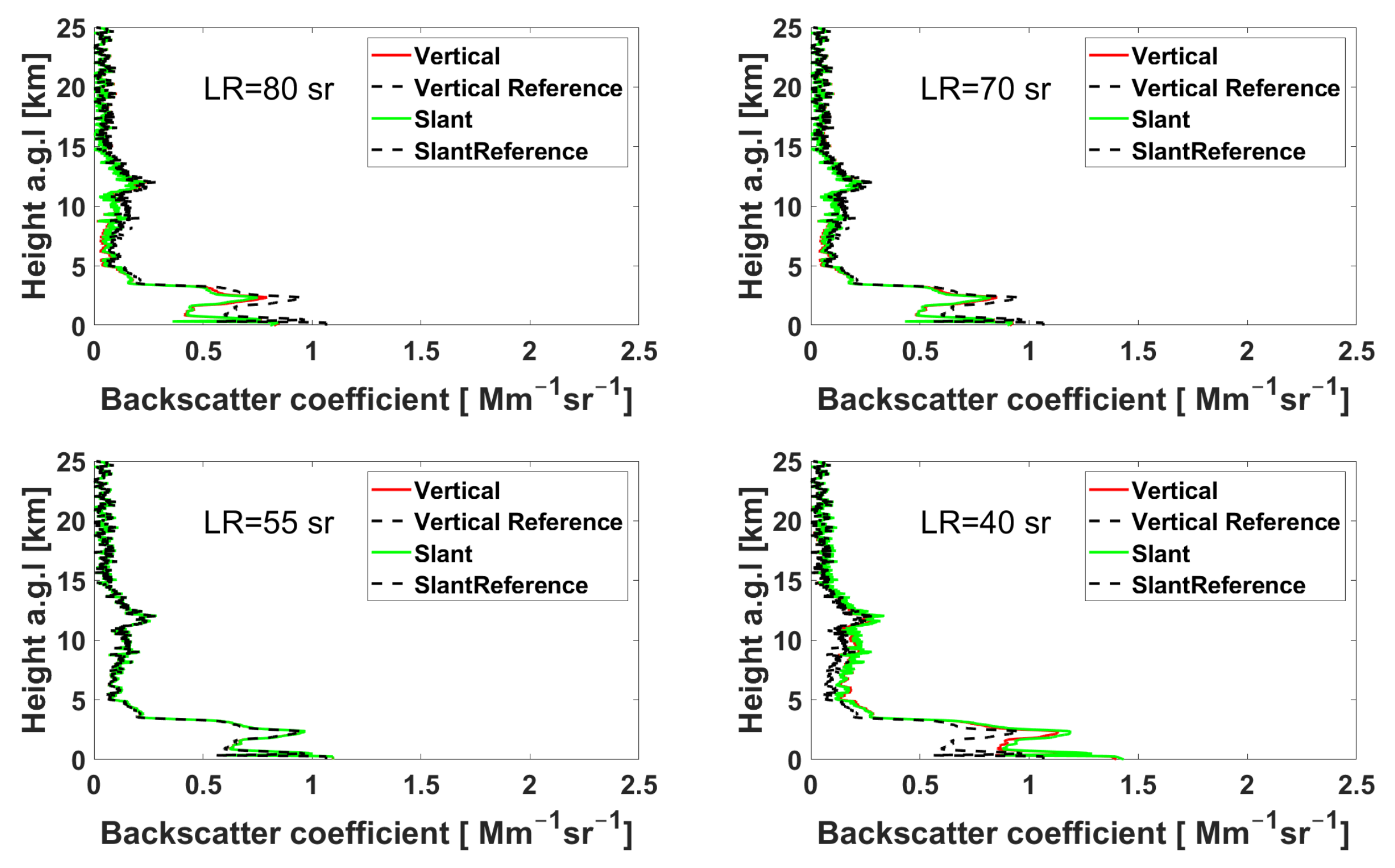
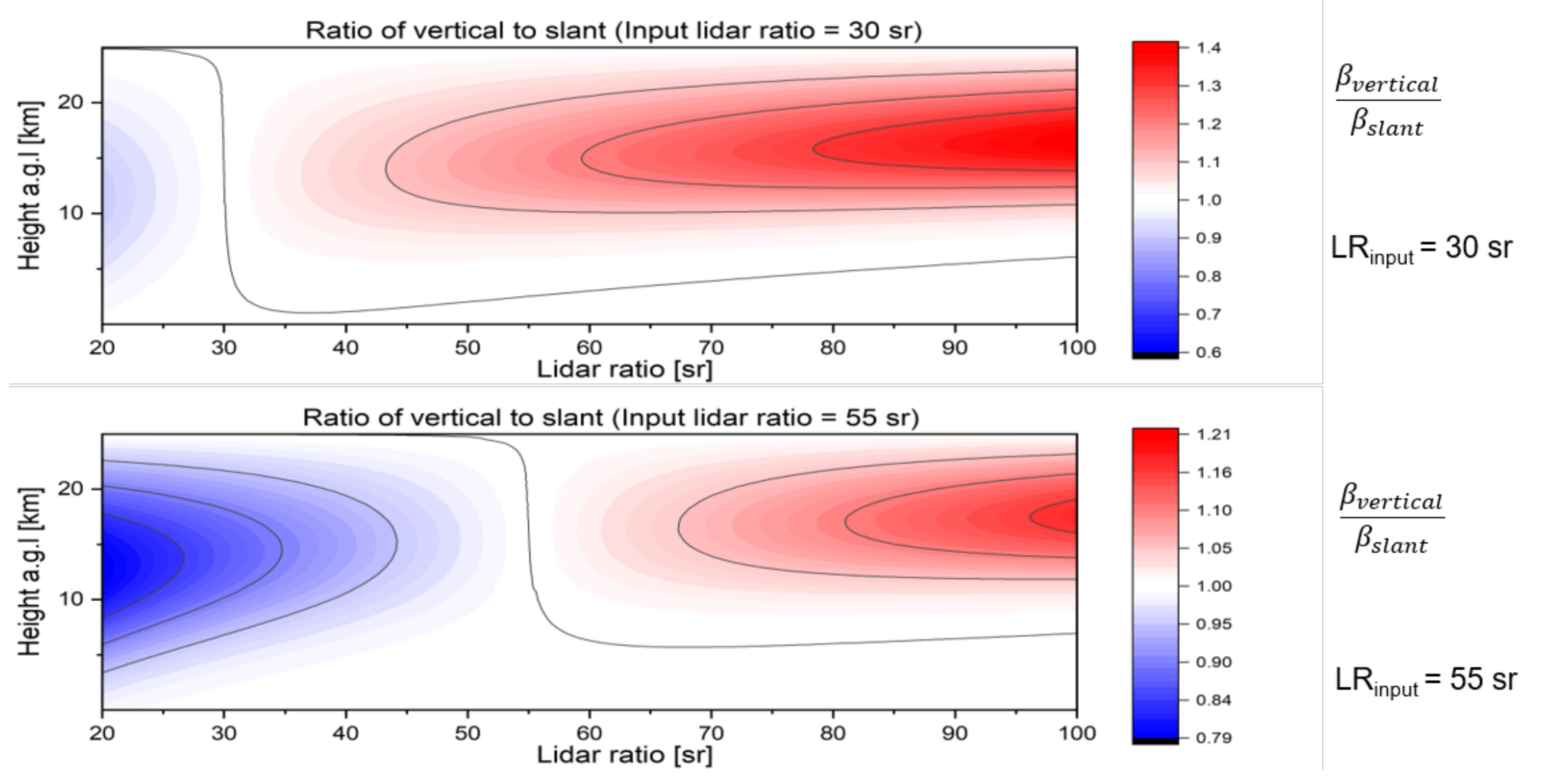
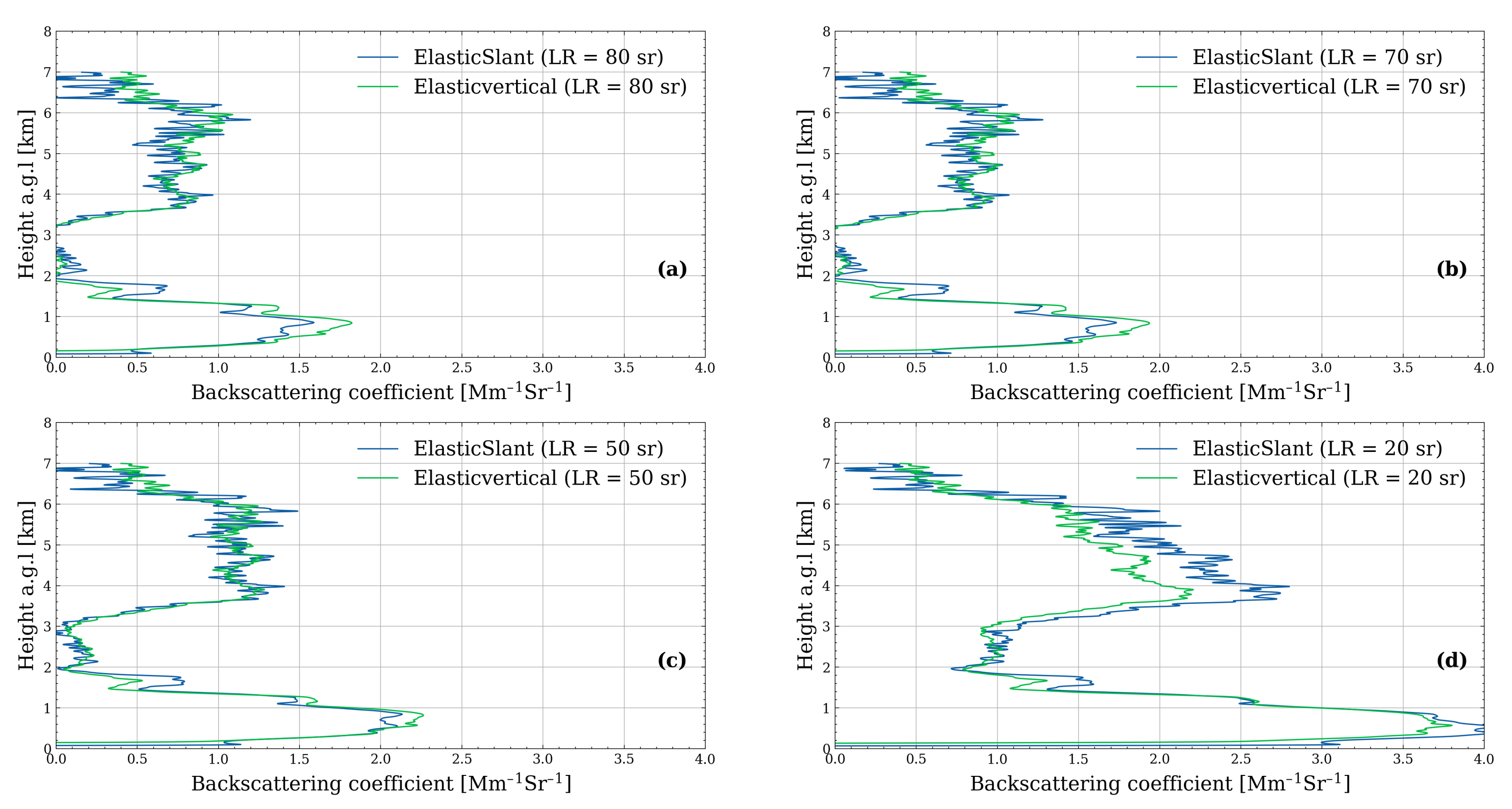
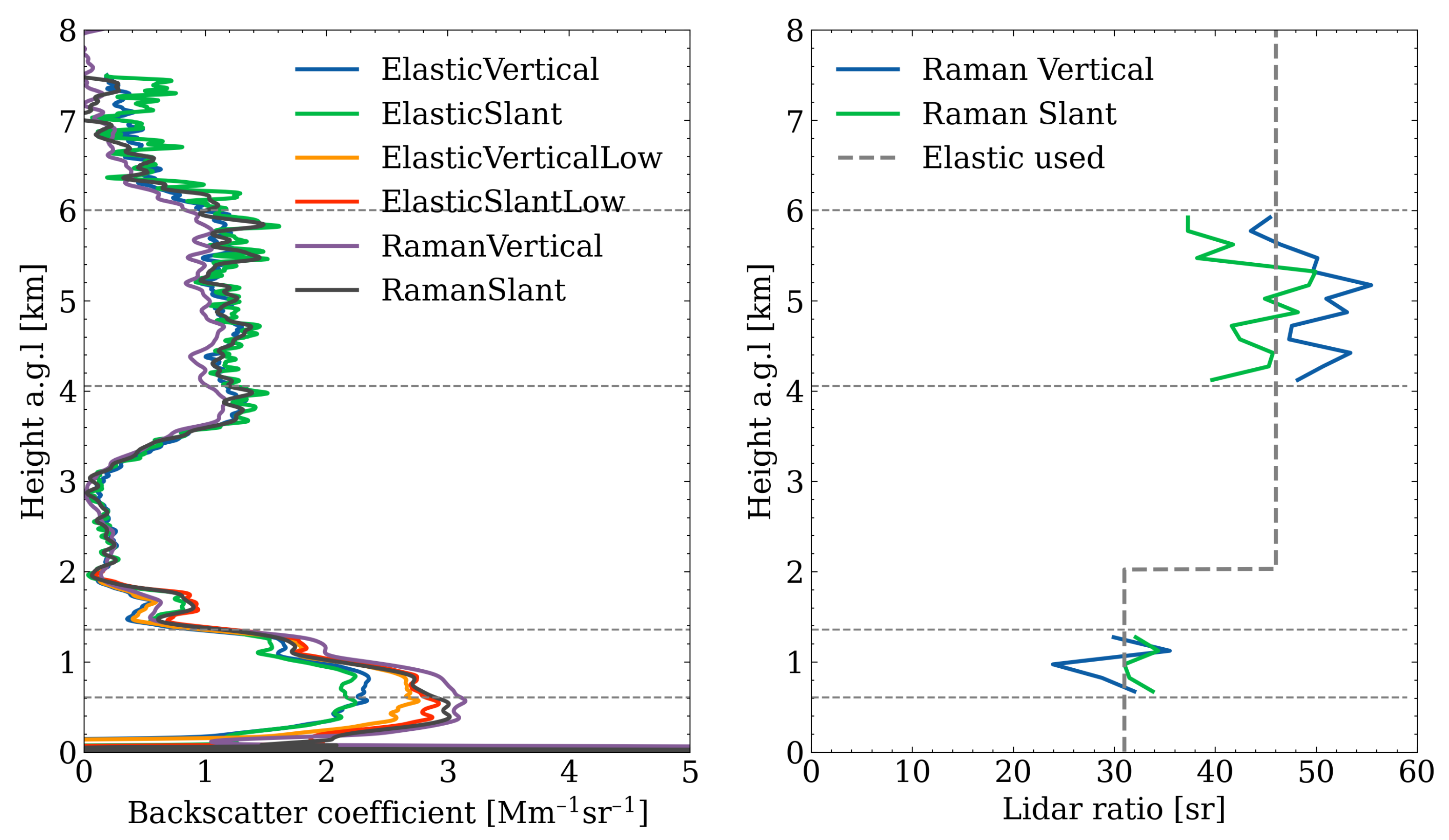
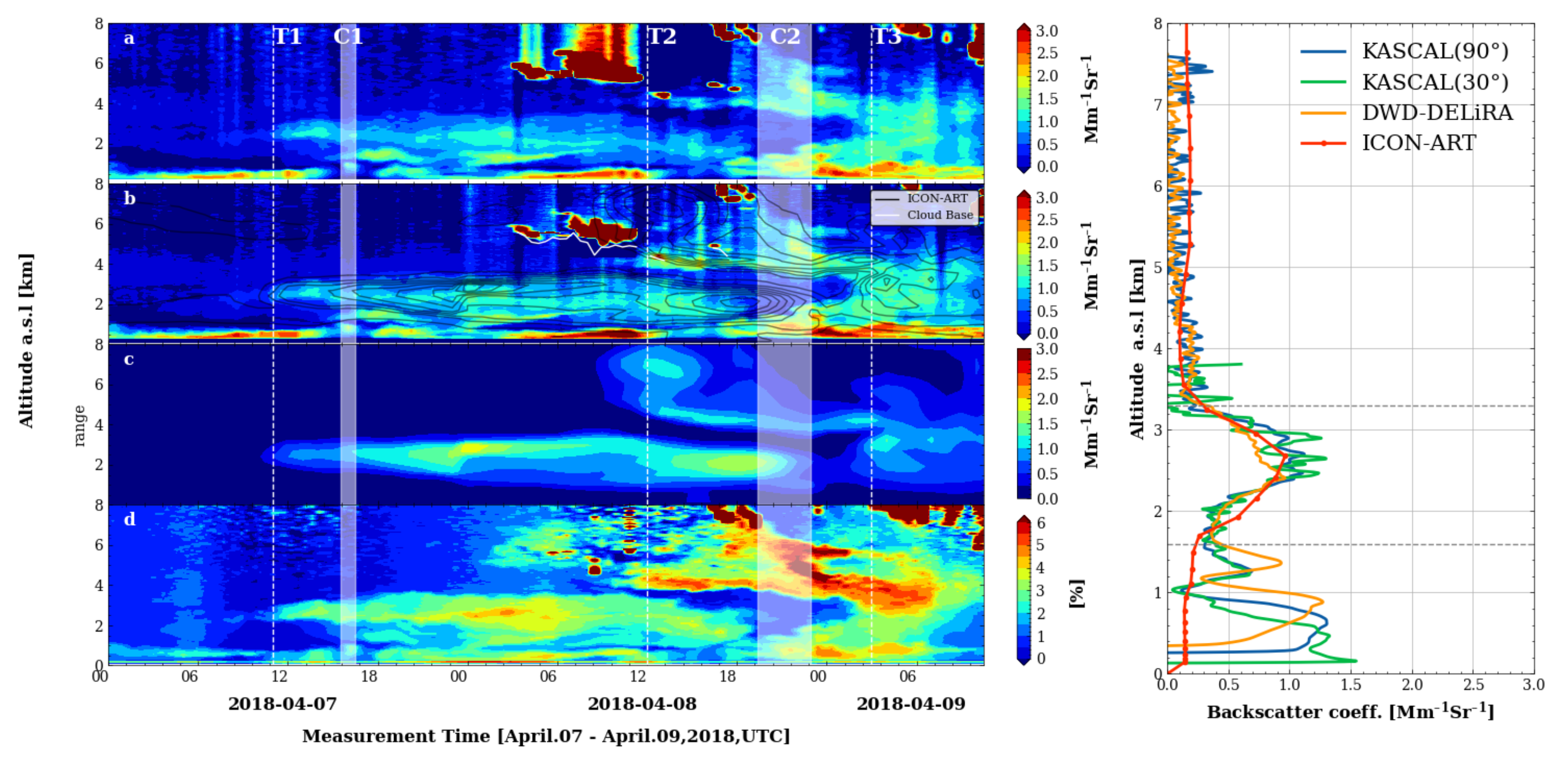

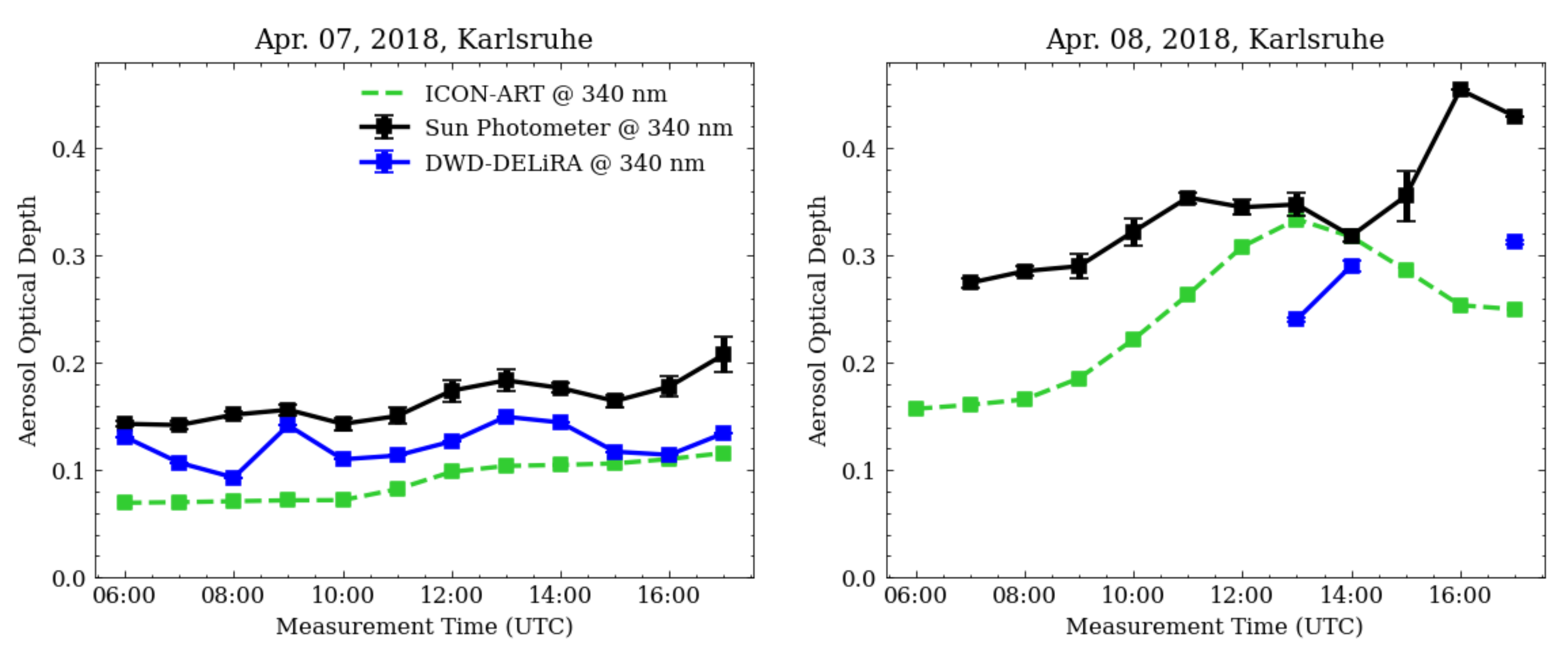
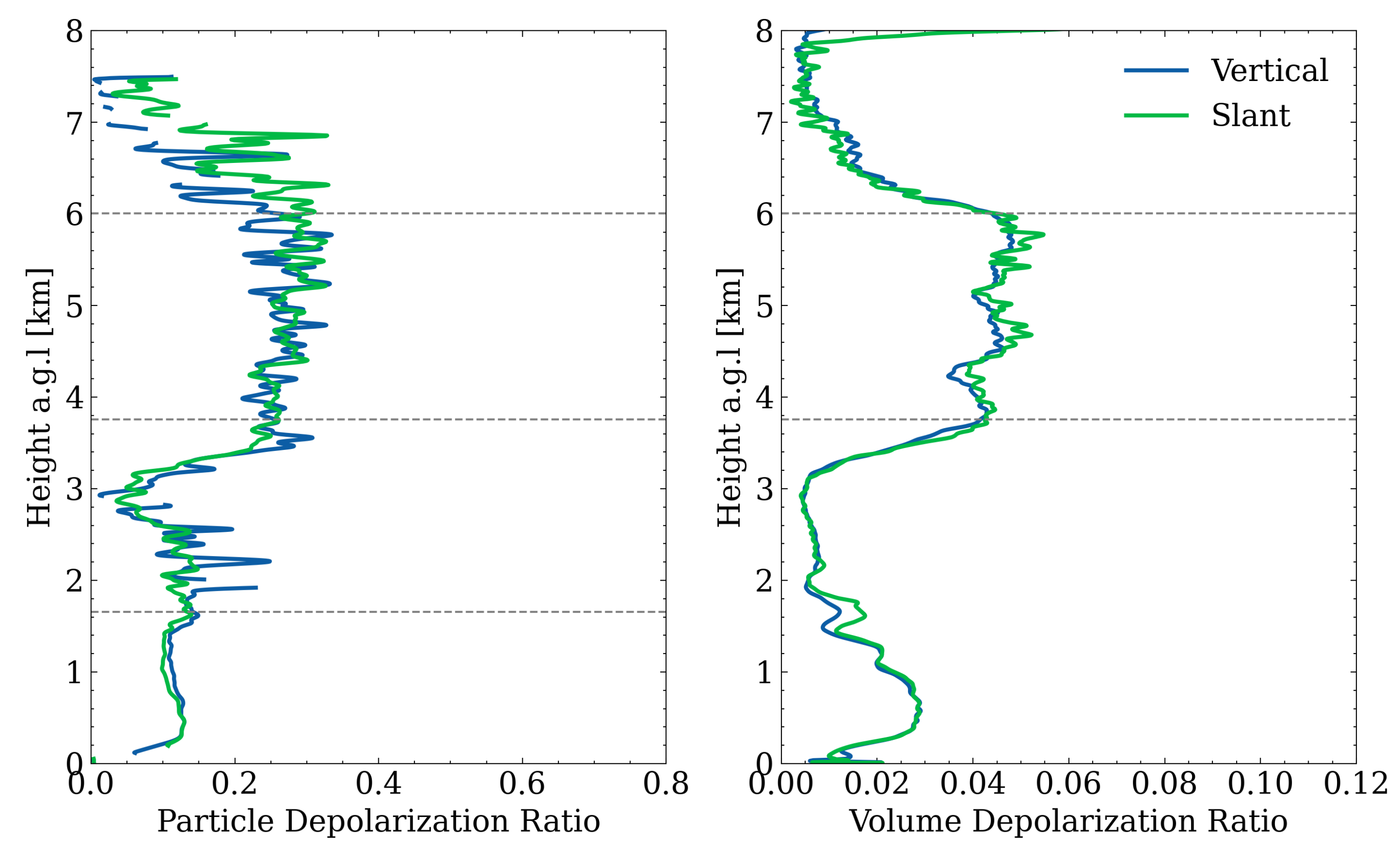
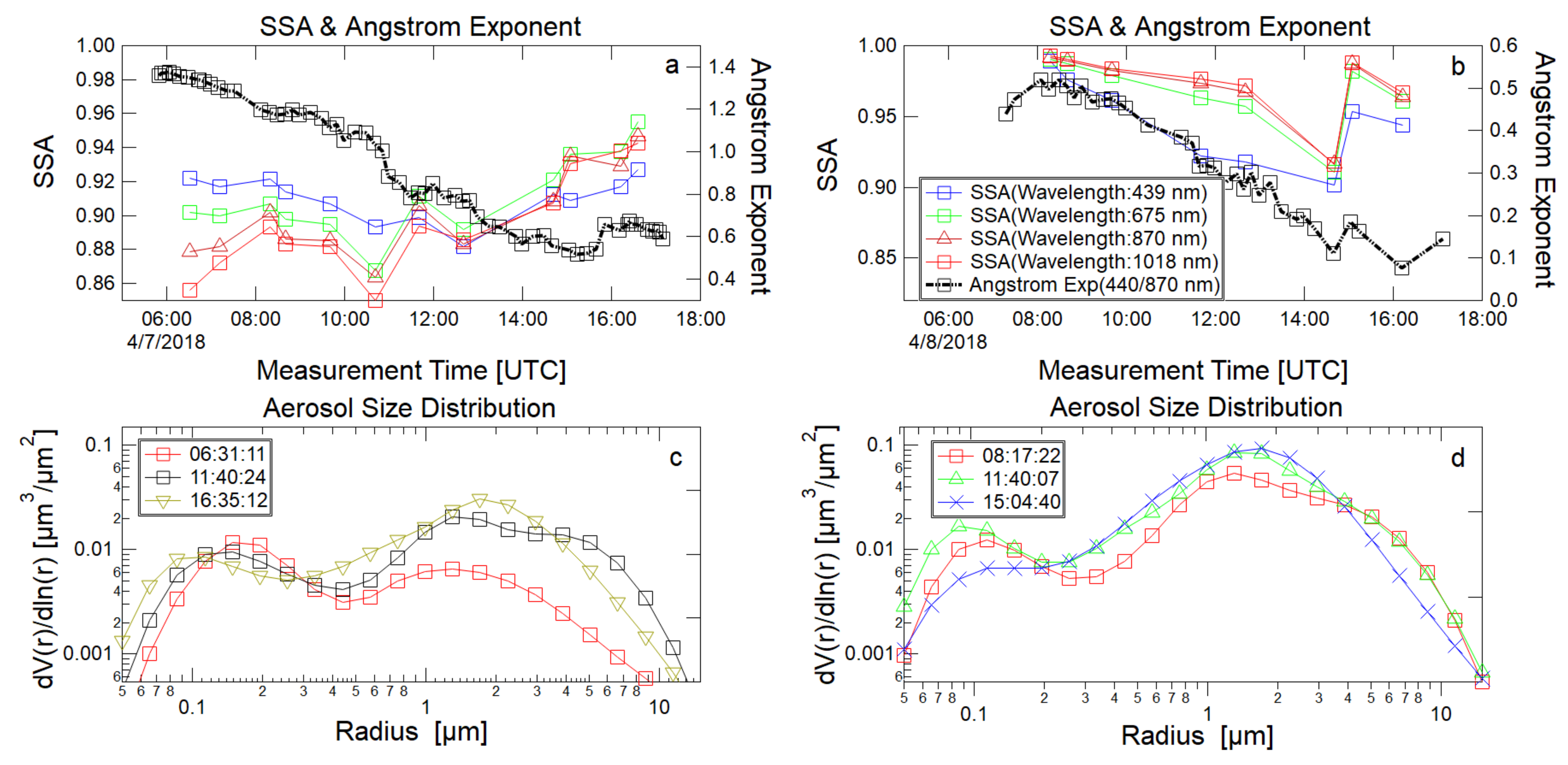
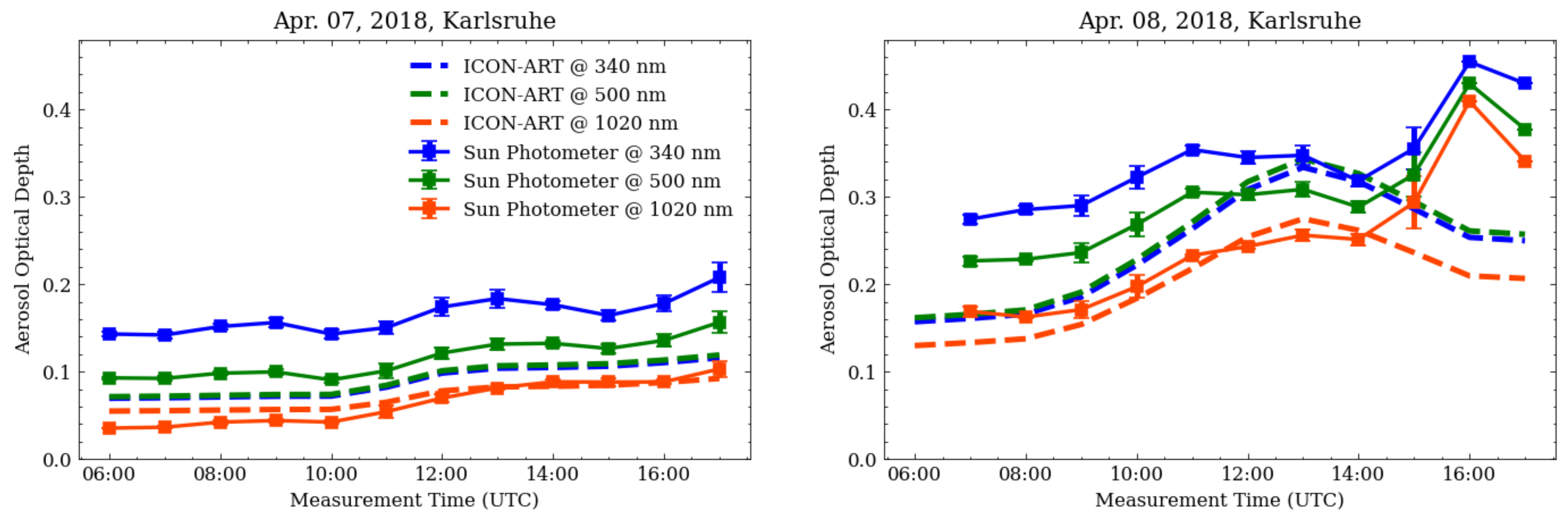

Publisher’s Note: MDPI stays neutral with regard to jurisdictional claims in published maps and institutional affiliations. |
© 2022 by the authors. Licensee MDPI, Basel, Switzerland. This article is an open access article distributed under the terms and conditions of the Creative Commons Attribution (CC BY) license (https://creativecommons.org/licenses/by/4.0/).
Share and Cite
Zhang, H.; Wagner, F.; Saathoff, H.; Vogel, H.; Hoshyaripour, G.; Bachmann, V.; Förstner, J.; Leisner, T. Comparison of Scanning LiDAR with Other Remote Sensing Measurements and Transport Model Predictions for a Saharan Dust Case. Remote Sens. 2022, 14, 1693. https://doi.org/10.3390/rs14071693
Zhang H, Wagner F, Saathoff H, Vogel H, Hoshyaripour G, Bachmann V, Förstner J, Leisner T. Comparison of Scanning LiDAR with Other Remote Sensing Measurements and Transport Model Predictions for a Saharan Dust Case. Remote Sensing. 2022; 14(7):1693. https://doi.org/10.3390/rs14071693
Chicago/Turabian StyleZhang, Hengheng, Frank Wagner, Harald Saathoff, Heike Vogel, Gholamali Hoshyaripour, Vanessa Bachmann, Jochen Förstner, and Thomas Leisner. 2022. "Comparison of Scanning LiDAR with Other Remote Sensing Measurements and Transport Model Predictions for a Saharan Dust Case" Remote Sensing 14, no. 7: 1693. https://doi.org/10.3390/rs14071693
APA StyleZhang, H., Wagner, F., Saathoff, H., Vogel, H., Hoshyaripour, G., Bachmann, V., Förstner, J., & Leisner, T. (2022). Comparison of Scanning LiDAR with Other Remote Sensing Measurements and Transport Model Predictions for a Saharan Dust Case. Remote Sensing, 14(7), 1693. https://doi.org/10.3390/rs14071693






